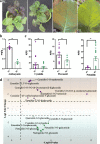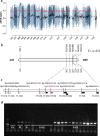The introgression of BjMYB113 from Brassica juncea leads to purple leaf trait in Brassica napus
- PMID: 39090544
- PMCID: PMC11295638
- DOI: 10.1186/s12870-024-05418-5
The introgression of BjMYB113 from Brassica juncea leads to purple leaf trait in Brassica napus
Abstract
The purple leaves of Brassica napus are abundant in anthocyanins, which are renowned for their role in conferring distinct colors, stress tolerance, and health benefits, however the genetic basis of this trait in B. napus remains largely unelucidated. Herein, the purple leaf B. napus (PL) exhibited purple pigments in the upper epidermis and a substantial increase in anthocyanin accumulation, particularly of cyanidin, compared to green leaf B. napus (GL). The genetic control of the purple leaf trait was attributed to a semi-dominant gene, pl, which was mapped to the end of chromosome A03. However, sequencing of the fragments amplified by the markers linked to pl indicated that they were all mapped to chromosome B05 from B. juncea. Within this B05 chromosomal segment, the BjMYB113 gene-specific marker showed perfect co-segregation with the purple leaf trait in the F2 population, suggesting that the BjMYB113 introgression from B. juncea was the candidate gene for the purple leaf trait in B. napus. To further verify the function of candidate gene, CRISPR/Cas9 was performed to knock out the BjMYB113 gene in PL. The three myb113 mutants exhibited evident green leaf phenotype, absence of purple pigments in the adaxial epidermis, and a significantly reduced accumulation of anthocyanin compared to PL. Additionally, the genes involved in positive regulatory (TT8), late anthocyanin biosynthesis (DFR, ANS, UFGT), as well as transport genes (TT19) were significantly suppressed in the myb113 mutants, further confirming that BjMYB113 was response for the anthocyanin accumulation in purple leaf B. napus. This study contributes to an advanced understanding of the regulation mechanism of anthocyanin accumulation in B. napus.
Keywords: BjMYB113; Brassica; Anthocyanin accumulation; CRISPR/Cas9; Leaf color; Map-based cloning.
© 2024. The Author(s).
Conflict of interest statement
The authors declare no competing interests.
Figures




References
MeSH terms
Substances
LinkOut - more resources
Full Text Sources
Miscellaneous

